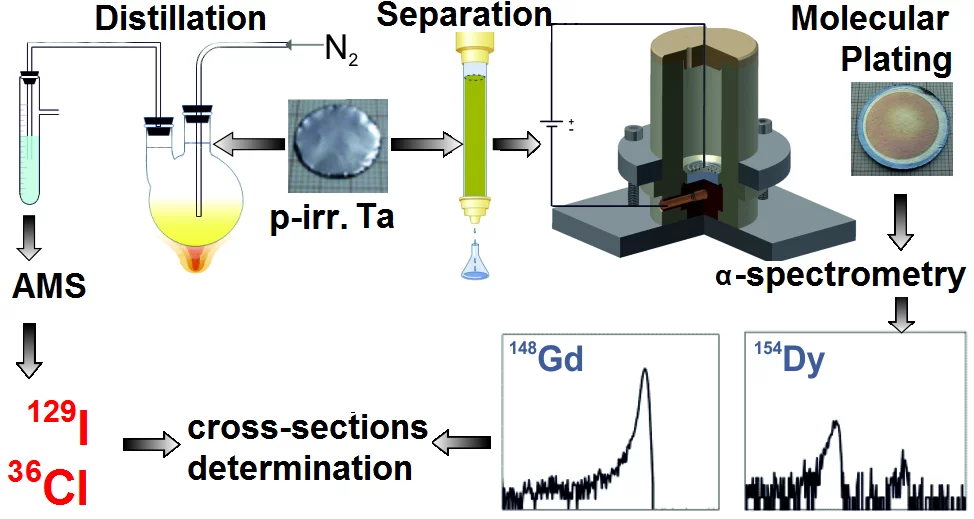Proton irradiations of lead, tantalum, and tungsten targets were performed twenty years ago at the SATURNE II synchrotron of the Laboratorie National Saturne (LNS) at Saclay. Due to a long time after irradiation, the short lived reaction products had already decayed. These targets were used to determine the production cross sections of long-lived α-emitting radionuclides (148Gd (T1/2 = 74.6 y), 154Dy (3 × 106 y)) and the long-lived β-emitting radionuclides (36Cl (T1/2 = 3.01 × 105 y) and 129I (T1/2 = 0.57 × 107 y)).
As a first step, radiochemical separation methods were developed to isolate these radionuclides. After separation, the measurements of 129I/127I and 36Cl/35Cl ratios were performed with accelerator mass spectrometry in collaboration with the Laboratory of Ion Beam Physics, ETH Zurich. Molecular plating technique was used to prepare thin and homogeneous lanthanides samples to obtain a good quality α-spectrum with high resolution and small low energy tail contribution. Autoradiography and focused ion beam/scanning electron microscopy techniques were used for the characterization of the lanthanide deposited layer.
The experimental results were compared with the theoretical calculations obtained with the combination of Liège intra-nuclear cascade (INCL++) and de-excitation phase (ABLA07) codes in collaboration with CEA/Saclay. The comparisons showed a satisfactory agreement for the 148Gd, 129I, and 36Cl cross-section results. In our work, it is clearly shown that radiochemical separation has a high impact for improving the accuracy of the results. However, theoretical 154Dy cross sections data were underestimated, which could be due to the high uncertainty of the accepted half-life value of 154Dy (3±1.5 My). Therefore, to increase the accuracy of the experimental cross-section data more precise half-life measurements are required. Corresponding measurements are currently ongoing in the frame of the ERAWAST project.
Contact
Dr. Zeynep TalipIsotope and Target Chemistry (ITC) Group
Laboratory for Radiochemistry (LRC)
Paul Scherrer Institut
Telephone: +41 56 310 4109
E-mail: zeynep.talip@psi.ch
Original Publications
Analysis of the 148Gd and 154Dy Content in Proton-Irradiated Lead TargetsZ. Talip, S. Pfister, R. Dressler, J. C. David, A. Vögele, P. Vontobel, R. Michel, D. Schumann
Analytical Chemistry 2017: Vol. 89, pp. 6861
DOI: 10.1021/acs.analchem.7b01353
Radiochemical Determination of Long-Lived Radionuclides in Proton-Irradiated Heavy-Metal Targets: Part I-Tantalum
Z. Talip, R. Dressler, J. C. David, C. Vockenhuber, E. M. Gubler, A. Vögele, E. Strub, P. Vontobel, D. Schumann
Analytical Chemistry 2017: Vol. 89, pp 13541
DOI: 10.1021/acs.analchem.7b03952

